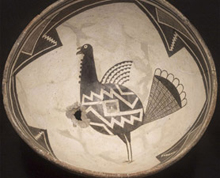The following is a repeat of an article posted November 18, 2010, but it bears repeating!
There are two main species of turkeys, the Wild Turkey (Meleagris gallopavo), which is native to the United States, Mexico, and Central America, and the Ocellated Turkey (Meleagris ocellata), which is native to the Yucatan Peninsula and Guatemala. The Oceallated Turkey is smaller and has never been domesticated, unlike the Wild Turkey which the early Aztecs called huexolotl and which they prized as a food source and revered as a god; modern dinner-table turkeys are descended from the birds they domesticated 2,700 years ago in Mesoamerica. The Spanish conquistadors took the birds to Spain about 1519, and from Spain they spread throughout Europe, reaching England shortly thereafter.
“Once the bird began to strut its stuff across the European continent, every different language settled on a different name. The result was a muddle. Adding to the confusion was that people mistook the word for ‘turkey’ as referring to the equally odd-looking guinea-fowl that were being imported from West Africa about the same period. The French called the turkey coq d’Inde, meaning rooster of India. This was shortened to dinde—the modern French word for turkey—but, as we know, it did not come from India. Columbus had sown the seeds of geographic confusion with his assessment that the New World was India. Nevertheless, the name-that-bird quest did not end there. In Arabic, the turkey was called the Ethiopian bird; to the Lebanese—the Abyssinian cock; the Portuguese called it the Peru bird, though there never was a turkey in that country either; in Greek it went by the name gallopoula, or French girl. Presumably, the Greeks got their first turkeys from the French. But it gets curiouser. In Malay, a turkey is ayam belanda, or Dutch chicken, though the Dutch and the Germans call it a Calicut chicken, after a southwest Indian seaport; and to cap it all, the Turks call the bird hindi, which sounds suspiciously Indian to me.
Two hundred years later, when the Swedish naturalist Carl Linnaeus tried to classify the turkey and its relatives in the natural scheme of things, he did not get it right either. He cobbled together the Latin name Meleagris gallopova. Well, meleagris is a guinea fowl, gallus is a chicken, and pova is a peacock—a mishmash if ever there was one. All in all, the turkey had Linnaeus stumped” (source).
So how did this prized bird end up being called a “turkey” in English? “About 1530, a new dish began to be put on English tables, a fowl a little larger than the traditional goose, but with a lot more meat and a refreshingly new taste. This bird had been brought to England by merchants trading out of that area of the eastern Mediterranean called the Levant but whom the English called ‘Turkey merchants’ because that whole area was then part of the Turkish empire. The new bird was therefore called a ‘Turkey bird’ or ‘Turkey cock.’ Within a few years, it had become a favourite and familiar domestic fowl, to the extent that, sixty years later, Shakespeare knew his groundlings would understand the reference to the turkey’s aggression display of blowing out its breast and strutting when he described the posturings of Malvolio in Twelfth Night: SIR TOBY BELCH: Here’s an overwheening rogue! FABIAN: O, peace! Contemplation makes a rare turkey-cock of him; how he jets under his advanced plumes!” (source).
By 1930, American Wild Turkeys had been hunted to near extinction, but today about 4.5 million of the wild birds roam 49 states (all except Alaska). According to the National Turkey Foundation, an estimated 247 million domesticated turkeys will be commercially raised in 2010. Wild or farmed, give thanks for the huexolotl you are about to eat this Thanksgiving.
Article by Bill Norrington; PS. Apologies for bowdlerizing the Bard: “What’s in a name? That which we call a rose/By any other name would smell as sweet.” Romeo and Juliet (II, ii, 1-2). PPS: Alumnus John Cloud (PhD 2000) points out that, “Related is the specific cluster of minerals, and a related range of colors, called “turquoise” because the minerals, as gem stones and art pigments, came from the Turkey merchants, but got to France first before entering into English. Probably the art angle.” Good point.




